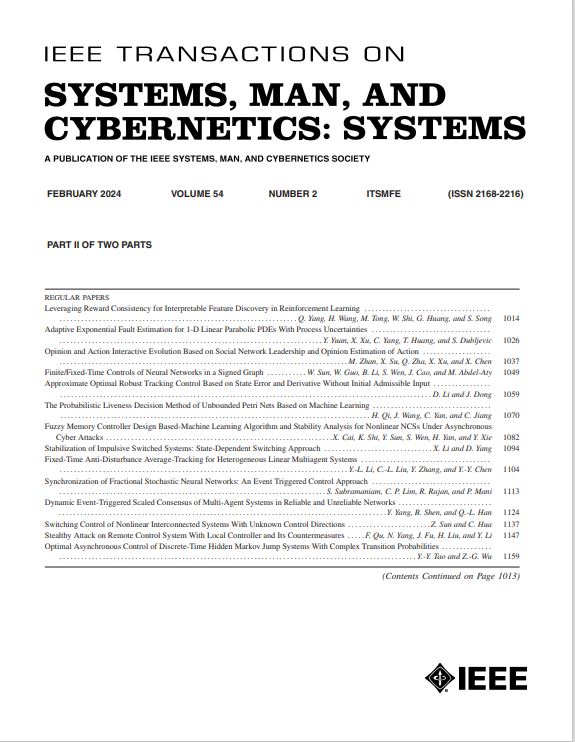具有衰减信道的模糊半马尔可夫跳跃系统的动态量化控制:改进的事件触发机制
IF 8.6
1区 计算机科学
Q1 AUTOMATION & CONTROL SYSTEMS
IEEE Transactions on Systems Man Cybernetics-Systems
Pub Date : 2025-02-19
DOI:10.1109/TSMC.2025.3537276
引用次数: 0
摘要
本文章由计算机程序翻译,如有差异,请以英文原文为准。
Dynamic Quantized Control of Fuzzy Semi-Markov Jump Systems With Fading Channels: An Improved Event-Triggered Mechanism
This article focuses on the dynamic quantized control for Takagi–Sugeno fuzzy semi-Markov jump systems (T–S FSMJSs) under fading channels and deception attacks, employing an improved event-triggered mechanism (ETM) strategy. Specifically, a more generalized semi-Markov process (SMP) that is governed by a higher-level deterministic switching signal (HLDSS) is addressed. A novel dynamic ETM is skillfully developed based on the information of quantization and two internal dynamic adjusting variables to further enhance the network bandwidth utilization. The dual asynchronous phenomenon between the plant and controller (asynchronous modes and mismatched premise variables) is addressed. This implies that the designed controller is not required to share the same membership functions and modes as the plant, establishing a more rational structure. The hidden semi-Markov model (HSMM) is attained to characterize the stochastic varying channel fading amplitudes. The Lyapunov function incorporating mode and fuzzy information is constructed to establish sufficient criteria ensuring the strictly dissipative performance and mean-square exponential stability (MSES) of the resulting closed-loop systems, and a new security fuzzy dual asynchronous controller is then developed. Finally, the efficacy and applicability of the results are demonstrated through numerical and practical examples.
求助全文
通过发布文献求助,成功后即可免费获取论文全文。
去求助
来源期刊

IEEE Transactions on Systems Man Cybernetics-Systems
AUTOMATION & CONTROL SYSTEMS-COMPUTER SCIENCE, CYBERNETICS
CiteScore
18.50
自引率
11.50%
发文量
812
审稿时长
6 months
期刊介绍:
The IEEE Transactions on Systems, Man, and Cybernetics: Systems encompasses the fields of systems engineering, covering issue formulation, analysis, and modeling throughout the systems engineering lifecycle phases. It addresses decision-making, issue interpretation, systems management, processes, and various methods such as optimization, modeling, and simulation in the development and deployment of large systems.
 求助内容:
求助内容: 应助结果提醒方式:
应助结果提醒方式:


